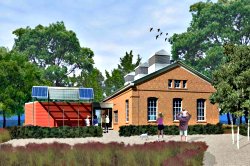National Association of State Park Directors Annual Conference, Boise, ID
September 2 – 5, 2008
Visit us at booth #44
American Society of Plumbing Engineers Engineered Plumbing Exposition, Long Beach, CA
October 27 – 28, 2008
Visit us at booth #1550 |
| eFact |
Topsoil in Turmoil
Iowa may have some of the most fertile land on the planet but those 2 feet of “cakey alluvial loam” are merely what’s left. As cornfields have replaced native prairie grasses over the last 150 years, winds and rain have washed away an estimated additional two feet of topsoil, which compounded over a 10,000 year period.
source: Pollan, Michael: The Omnivore’s Dilemma. A Natural History Of Four Meals. |
| Also of Interest |
Fresh off the Press
Queens Botanical Garden’s new Visitor/Administration Building was featured in the cover story of the April issue of GreenSource. Clivus Multrum Foam-flush composting toilets are installed for staff use in accordance with the planning group’s particular interest in integrating water-consciousness into the building.
Another Clivus project, the Sweetwater Creek State Park Visitor Center, outside Atlanta, is described in the April issue of Architectural Products. According to the article, entitled “Achieving LEED,” Clivus Multrum composting toilet systems allowed the Visitor Center to earn LEED points in the Innovative Waste Water Technologies and Water Use Reduction categories. The visitor center has four, large composters, with one Foam-flush toilet for staff use and seven waterless fixtures for public use.
The Foam-flush fixture is also featured in the July/August issue of Dwell, in a review of “eco-toilets.”
Maintenance Services
Did you know that Clivus can arrange to provide your facility with composting system maintenance services? Clivus offers a variety of maintenance options to meet your needs. No matter where your facility is located, we’ll come to you or work with local subcontractors to ensure that the job is done right. Call us at 800-425-4887 for more information. |
|
Greetings from Clivus Multrum!
In this issue, we describe two New York-based organizations, the Beacon Institute for Rivers and Estuaries and Anglebrook Golf Club, who contacted Clivus Multrum to help them address their need for minimally invasive, sustainable waste treatment systems.
Beacon of Sustainability
 |
| An exterior rendering of The Beacon Institute for Rivers and Estuaries' Building One at Denning's Point in Beacon, NY .* |
The Beacon Institute for Rivers and Estuaries is a not-for-profit research organization with the mission “to create and maintain a global center for scientific and technological innovation that advances research, education and public policy regarding rivers and estuaries.” Since its inception, The Beacon Institute has been a bold voice for 21st century environmentalism.
The Beacon Institute engages scientists, engineers, educators and policy experts in collaborative work focusing on real-time monitoring of river ecosystems. The Institute’s flagship initiative, the River and Estuary Observatory Network (REON), is a joint effort between The Beacon Institute, IBM and Clarkson University to create the first an integrated network of sensors, robotics and computational technology distributed throughout the 315-mile Hudson River. REON will offer invaluable insights into the interdependence of the physical, chemical and biological components of rivers and estuaries.
REON’s promise will be realized in Building One, the first facility in The Beacon Institute’s planned campus at Denning’s Point State Park in Beacon, New York. Soon to be renamed the Center for Environmental Innovation and Education, Building One is a model of green design and an adaptive reuse of an existing late-nineteenth century 4,000-square-foot brick structure that will open to the public in the next few months. Building One will also serve as a visitors’ center for the park, and house The Beacon Institute’s education, technology, and policy programs.
| Regan Chichester, Project Manager for The Beacon Institute, said the Clivus Multrum composting toilets were “simply the best option.” |
Built to achieve LEED certification, Building One includes two large Clivus Multrum composters and three Foam-flush toilet fixtures to serve staff and visitors, in addition to numerous other green building technologies. The Foam-flush toilets use just 3 ounces of water per flush, and have the potential to save over 200,000 gallons of water annually, compared to 1.6 gpf toilets. In addition to conserving water, Clivus compost systems do not require any connections to a septic system or sewer. Instead, they treat waste onsite, using natural, biological decomposition to convert excreta into stable, dry and liquid fertilizer end-products. Use of these composting systems is closely tied to The Beacon Institute’s vision to “create the innovations that will harmonize the daily activities of the human community with the continuing needs of the local and global environment.”
After many years of successful use in various New York state parks, Clivus Multrum systems have become the standard for such projects. Regan Chichester, Project Manager for The Beacon Institute, said the Clivus Multrum composting toilets were “simply the best option.” While the composting systems have been used so far only on a limited basis by staff and construction personnel, Chichester says the users have been very happy with the systems, and she foresees no problems when they are running at full capacity later this year.
In addition to the Clivus composting systems, Building One features a number of other green design technologies. Solar and geothermal energy sources are used to light, heat, and cool the building. Wind towers on the roof provide natural ventilation, and a green roof captures and filters rain water while helping to regulate the building’s temperature. In addition to protecting and conserving natural resources, Building One’s green technologies will be used as a teaching tool. Handouts, tours, and a film will help inform visitors about composting toilets and other green features, and inspire a new generation of sustainability advocates.
*Image courtesy of Gensler
Approaching Golf Course Restrooms from a New Angle
 |
| M54 Trailhead on the 14th hole at Anglebrook Golf Club Lincondale, NY.* |
The Clivus Multrum M54 Trailhead, a composting system with integrated building structure, is a great solution for remote locations with limited access to utilities. Recently, these systems have become a popular choice for award winning golf courses looking to provide golfers the added convenience of mid-course restrooms.
The Anglebrook Golf Club in Lincolndale, NY is the final design of famed golf course architect Robert Trent Jones, Senior. The 240 acre course opened for its first full season in 1998. It has not taken Anglebrook long to establish its reputation as one of the finest and most challenging golf courses in New York. Within its first year of operation, it was ranked among the top 20 courses in New York by Golf Digest. Only one thing was lacking.
Previously, golfers had to complete the first 9 holes before reaching a restroom. In response to a recent member survey, Anglebrook Superintendent Lou Quick investigated options for adding restrooms to the course. “I thought, ‘How can we do this environmentally, with ease of construction and minimal disturbance?’” After posting an inquiry on TurfNet.com, a fellow superintendent pointed him toward the Clivus Multrum M54 Trailhead, and he never looked back. Quick ordered two Trailheads and installed them on both edges of the course, at holes five and fourteen.
| Quick opted for the Foam-flush fixtures in order to ensure user acceptance of the systems, remarking, “It’s all about perception, and we have very discriminating members.” |
Clivus Multrum representatives assisted with the assembly and installation of the first unit, which allowed Quick and his staff to handle the second one easily on their own. The Trailheads at Anglebrook use Foam-flush toilet fixtures that tap into the course irrigation to provide the minimal amount of water needed for flushing (3 oz. per flush). Quick opted for the Foam-flush fixtures in order to ensure user acceptance of the systems, remarking, “It’s all about perception, and we have very discriminating members.”
That perception doesn’t stop with the Foam-flush toilets. The Trailheads at Anglebrook have a stone façade and cedar shingles, which were applied by Quick’s staff (these are also available in a pre-fabricated unit directly from Clivus). Stone pathways form the approach to the toilet structures. Inside, plants, a vanity, and course photography complete the decor. Members have been pleased, commenting that the new systems are convenient, clean, and attractive. Quick has been equally impressed. When asked if he might recommend the Clivus Multrum Trailhead to others, Lou Quick said, “Absolutely, gushingly so. It’s such a great solution for our golf course.”
*Photo courtesy of Lou Quick |
